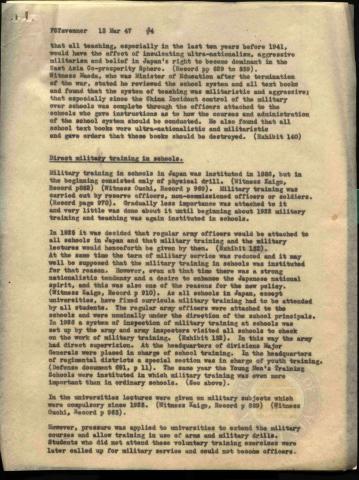
Page 4
| Parent | Educational System in Japan |
|---|---|
| Date | 13 March 1947 |
| Language | English |
| Collection | Tavenner Papers & IMTFE Official Records |
| Box | Box 4 |
| Folder | General Reports and Memoranda from March 1947 |
| Repository | University of Virginia Law Library |
FSTavenner 13 Mar #4
that all teaching, especially in the last ten years before 1941, would hare the affect of inculcating ultra-nationalism, aggressive militarism and belief in Japan's right to become dominant in the East Asia Co-prosperity Sphere, (Record pp 829 to 839). Witness Maeda, who was Minister of Education after the termination of the war, stated he reviewed the school system and all text books and found that the system of teaching was militaristic and aggressive that especially since the China Incident control of the military ever schools was complete through the officers attached to the schools who gave instructions as to how the courses and administration of the school system should be conducted. He also found that all school text books were ultra-nationalistic and militaristic and gave orders that these books should be destroyed. (Exhibit 140)
Direct military training in schools.
Military training in schools in Japan was instituted in 1886, but in the beginning consisted only of physical drill. (Witness Kaigo, Record p882) (Witness Ouchi, Record p 969). Military training was carried out by reserve officers, non-commissioned officers or soldiers. (Record page 970). Gradually less importance was attached to it and very little was done about it until beginning about 1922 military training and teaching was again instituted in schools.
In 1928 it was decided that regular army officers would be attached to all schools in Japan and that military training and the military lectures would henceforth bo given by them. (Exhibit 132). At the same time the term of military service was reduced end it may well be supposed that the military training in schools was instituted for that reason. However, even at that time there was a strong nationalistic tendency and a desire to enhance the Japanese national spirit, and this was also one of the reasons for the new policy. (Witness Kaigo, Record p 910). As all schools in Japan, except universities, have fixed curricula military training had to be attended by all students. The regular army of floors were attached to the schools and were nominally under the direction of the school principals. In 1926 a system of inspection of military training at schools was set up by the army and army inspectors visited all schools to check on the work of military training. (Exhibit 182). In this way the army had direct supervision. At the headquarters of divisions Major Generals were placed in charge of school training. In the headquarters of regimental districts a special section was in charge of youth training. (Defense document 691, p 11). The same year the Young Men's Training Schools were instituted in which military training was even more important than in ordinary schools. (See above).
In the universities lectures were given on military subjects which were compulsory since 1928. (Witness Kaigo, Record p 889) (Witness Ouchi, Record p 968).
However, pressure was applied to universities to extend the military courses and allow training in use of arms and military drills. Students who did not attend these voluntary training exercises were later called up for military service and could not become officers.
